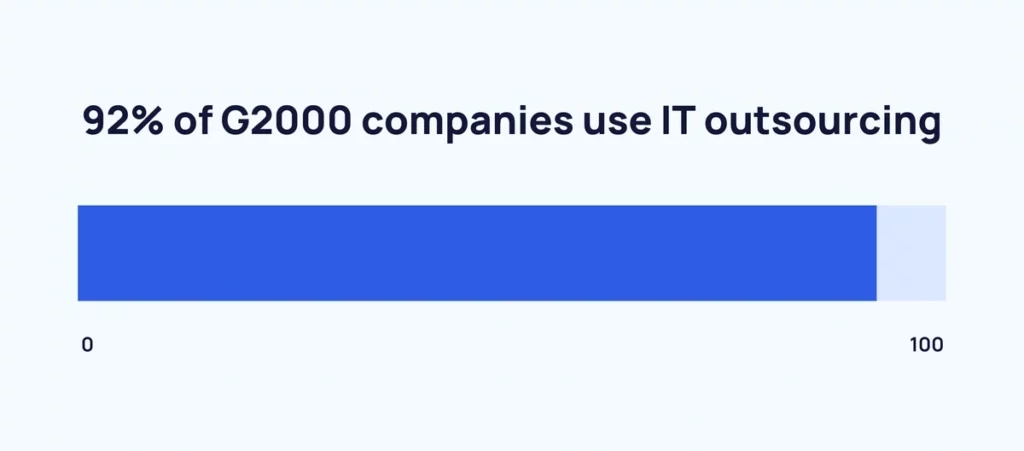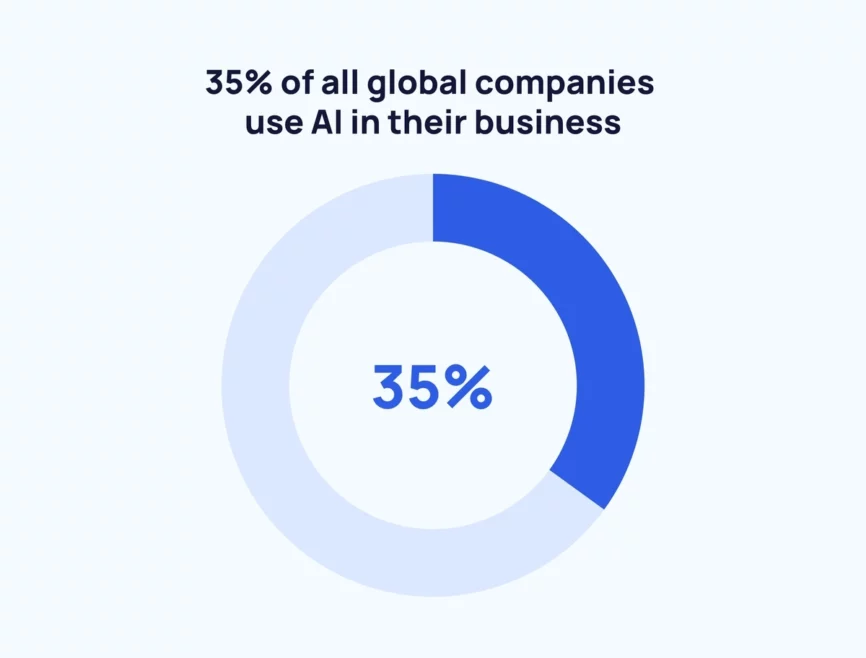The overall IT outsourcing industry has experienced rapid development in recent years. Nowadays, companies are eager to stay ahead of the market, therefore they focus more on IT outsourcing. With USD 1,149.24 billion at an annual growth rate (CAGR) of 8.2%, the global IT outsourcing market will reach its mark in 2032.
Consequently, small and medium businesses and big enterprises are searching for IT outsourcing services to hire highly skilled professionals. They have realized that hiring specialists outside the organization for software development and technical support, helps them to stay competitive and quickly respond to changes in the market.
Now, let us explore the global IT outsourcing statistics, explore insights, and trends in depth.
50+ Global IT Outsourcing Statistics Shaping Tomorrow’s Landscape
With the increasing complexity of IT tasks, the demand for outsourcing services continues to rise. Here we will discuss the top 50+ IT outsourcing statistics that encapsulate the industry’s growth and significance.
Outsourcing Forecast: Outsourcing Market Statistics for 2024
1) The global BPO outsourcing market was USD 280.64 Billion in 2023 and is projected to grow at a CAGR of 9.4% from 2023 to 2030.
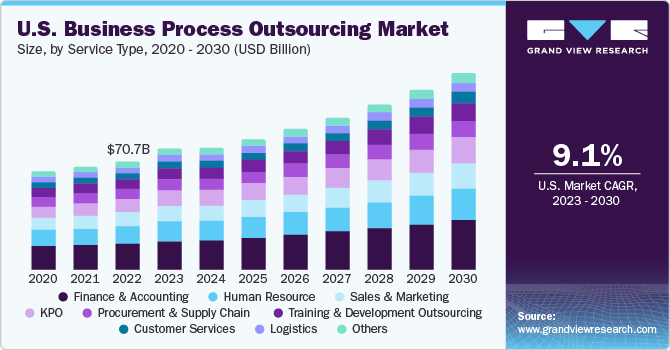
This development is driven by digital transformation, cost optimization focus, and the increasing demand for specialized services. As companies are focusing more on efficiency and agility, BPO will be a strategic imperative. This would enable them to efficiently leverage external expertise and resources for long-term success and competitive advantage.
2) Global IT Outsourcing budget escalated to 13.6% in 2020 from 12.7% in 2019.
This increase clearly demonstrated that the usage of outsourced IT services to satisfy the need for digital solutions is growing significantly. The shift towards online operations and remote working forced many businesses to adopt outsourcing as an integral move. It gave them operational stability, efficiency, and flexibility to the fast-changing technology.
3) Almost 36% of workers in the US are a part of the Gig economy.
This dynamic landscape of the Gig economy is characterized by short-term or freelance engagements, offering workers flexibility and autonomy in their schedules and projects. It encompasses various sectors, including food delivery, freelance work, and online marketplaces. And technological outsourcing is the major facilitator of this market. More than one-third (36 percent) of U.S. workers are in the gig economy approximately 57 million people.
4) Accenture is the biggest outsourcing company in 2023 globally.
In 2023, Accenture became the largest IT outsourcing company globally. Accenture is a leading provider of innovative solutions to enterprises around the world with a wide portfolio that covers IT infrastructure management, business process outsourcing, consulting, and application development. Besides commendable services, they also bagged stars for customer references, programs for innovation and CSR, and champs for multiple certificates and awards.
5) Every year, approximately 300,000 jobs are outsourced from the United States.
According to the report, about 300,000 jobs are outsourced from the USA annually. These IT outsourcing statistics demonstrate the powerful effect of outsourcing on the American labor force and economy. Although outsourcing can result in cost savings and productivity for businesses, it also raises issues of job loss and wage stagnation in some industries.
6) Cloud computing is a primary enabler of outsourcing by 90% of companies.
This figure highlights the important role of cloud technology in allowing companies to efficiently outsource different IT functions and processes. The cloud lends scalability, flexibility, and accessibility to companies improving their operational processes.
7) G2000 companies (92%) have contracts for business process outsourcing.
This figure highlights the utilization of outsourcing strategies by the top players who want to improve efficiency, concentrate on core competencies, and foster innovation. G2000 companies also benefited from specialization, scalability, and cost optimization when they outsourced non-core IT functions like customer support, finance, and human resources. It allowed them to adapt to market dynamics and sustain competitive advantages in the business environment.
8) 78% of businesses have good relations with their outsourcing partners.
The IT outsourcing statistics depict the fact that companies maintain strong partnerships with their contractors, suppliers, and clients. Strong partnerships deliver innovation, agility, and responsiveness, allowing companies to adapt and meet the challenges of the market.
9) 37% of small businesses outsourced their IT needs.
Small businesses can concentrate on their core competencies, improve efficiency, and reduce overhead costs by outsourcing duties. Outsourcing provides an opportunity to use specialized knowledge and flexibility to scale operations as necessary. Even though small businesses face challenges like budget constraints, outsourcing has become a useful approach for them to streamline their operations and be competitive in their market.
Outsourcing Landscape: General IT Outsourcing Statistics
Now, let’s explore some general worth-knowing IT outsourcing stats expanding the picture of IT outsourcing in the market.
10) 70% of the users confirmed cost reduction as the main objective of outsourcing.
Companies outsource their operations with the desire to make more efficient savings on labor, infrastructure, and overhead costs. Its primary emphasis is on cost-saving in the modern international market that interests competitiveness and profitability.
11) 76% of executives accepted to outsource their business IT functions.
As per a survey conducted by Deloitte, a major 76 percent of surveyed executives adopted IT outsourcing to accelerate their organizational processes. Next-gen tech implementation, cybersecurity, setting up IT ecosystems, and app and custom software development are some of the major tasks outsourced to the service providers.
12) The outsourcing market size was recorded at $92.5 billion in 2019.
Outsourcing has lately become a basic pillar for those companies that intend to improve their efficiency, reduce their costs, and access specialized skills. The growing importance of the outsourcing market shows its significant contribution to the current business system, through flexibility, scalability, and global competitiveness.
13) 83% of small businesses increased their BPO budget in 2023.
Small businesses assign a part of their resources to BPO initiatives as a measure to streamline processes and scale their business through increased online presence. This transformation highlights outsourcing and helps them to effectively identify and take advantage of opportunities that will lead to sustainable growth and expansion.
14) The business process outsourcing will get to $544.8 billion by 2032.
Delegating non-key tasks to outside service providers enables companies to concentrate on fundamental competencies and innovation. With the growing reach of BPO, outsourcing remains a strategic component of the business growth plan to drive growth and innovation.
15) Banks outsource at least 40% of their help desk jobs.
Outsourcing help desk services to third-party providers enables banks to prioritize their main processes. This inclination speaks to the industry’s commitment to the use of outsourcing as a main pillar of their business strategies.
16) 66% of large companies leverage outsourcing more compared to small businesses.
These IT outsourcing stats suggest that larger companies outsource their IT services more than small businesses to meet their broad range of digital requirements. It helps them with scalability, specialized resource availability, and cost efficiency. Thus, outsourcing is an appealing choice for process simplification, innovation, and competitiveness.
17 ) 60% of B2B brands are getting their marketing assistance from outside resources.
Outsourcing marketing work has helped B2B brands carry out their operations smoothly, cut costs, and meet the demands of the dynamic market. Tasks such as content creation and management, designing marketing and sales campaigns, expert consulting, lead generation, customer acquisition processes with strategic precision, and many more, are handled through IT outsourcing for optimizing brand awareness.
18) Up to 50% of all B2B marketers rely on outsourcing for content marketing activities.
By outsourcing the content creation, distribution, and analytics, B2B marketers can get hold of the skills, simplify the workflows, and allocate resources more efficiently. Outsourcing marketing content activities empowers businesses to stay adaptive to market fluctuations.
19) 35% of global companies report using AI in their business.
This is an indication that AI-driven innovation is increasingly one of the most influential reasons for outsourcing services. Businesses are taking advantage of AI technologies such as machine learning (ML), natural language processing, deep thinking, and computer vision to make processes more efficient and automate them.
20) Manufacturing owners outsource nearly 70%–80% of their final products.
Through this IT outsourcing strategy, businesses can reduce their overall production cost, access specialized facilities, and improve the speed of market launch. Notably, offshoring production processes has helped organizations maximize resource utilization, eliminate operational hazards, and increase focus on the business’s key functions like creativity and marketing.
21) In the US, small businesses with less than 50 employees outsource 29% of their work.
These IT outsourcing stats are suggestive of the fact that outsourcing gives flexibility to any type and size of business. Especially for small businesses that can scale their operations depending on the market demand and avoid the heavy burden of maintaining in-house capabilities. Such a strategic approach allows them to manage multiple operations with limited in-house resources to achieve business growth.
22) HR consulting is the most frequently outsourced among organizations.
Through teaming up with HR consultants, developing efficient HR management systems (HRMS), employee management software, etc., organizations streamline their workflows, optimize approaches, and have strategic advice to make their HR functions business-oriented.
23) 90% of top companies globally have embraced RPA as a digital enabler in 2022.
Robotic Process Automation, or RPA, enables the automation of routine tasks, allowing businesses to enhance effectiveness by streamlining their workflows, minimizing errors, and concentrating their human resources on more value-added activities. Through RPA utilization, organizations get error-free accuracy and process speed-up.
24) In the UK, 34% of the organizations are outsourcing IT support.
This kind of outsourcing is a targeted initiative aimed at improving efficiency, scalability, and access to top-notch technological solutions in a competitive environment.
25) The two most outsourced tasks are writing (44%) and design (41%).
Content writing and designing are the main drivers of any marketing campaign, demanding a high level of expertise for guaranteed results. Through outsourcing, businesses can remove these tasks from their plates and pass them on to external experts. This makes the content creation process smoother, maintains the quality of the work, and enables the business to focus on core strategic initiatives that will help drive brand awareness and engagement.
26) The most common service outsourced is lead generation.
As a backbone of growth, sales and marketing departments outsource lead creation to get expert insights and cover a wider market audience for their business growth. This strategic approach underscores the evolving landscape of modern business practices, emphasizing efficiency and results-driven strategies.
IT Outsourcing Statistics – Geographical Distribution
The IT services global market majorly operates in two sets of regions, with one being the Asia-Pacific and Europe, while the other being North America, leading the world in growth rates and market shares. Let’s look at some of the interesting IT outsourcing stats based on geography.
27) The Philippines contributes 9% to its GPD through IT outsourcing and service.
The Philippines is now considered a competent country offering IT outsourcing services, becoming the backbone of its economy. Factors such as strategic position, English-speaking population, and business-friendly environment helped this country to be a favorite destination with outsourcing needs. In the Asia-Pacific region, the Philippines is the best affordable country for outsourcing today.
28) 59% of businesses globally are already outsourcing in India.
India is the leader in the IT outsourcing industry, as it provides about 59% of the total outsourcing services worldwide. India has become a sought-after location for outsourcing needs including IT services, customer support, and business process outsourcing (BPO). The country’s huge English-speaking, technical talent pool lures businesses looking for high-quality Software Outsourcing services in India at affordable prices.
Moreover, India’s conducive business environment, strong infrastructure, and supportive government policies make it a leading outsourcing destination. That’s why nowadays outsourcing to India is a most preferable option.
29) India’s IT outsourcing sector is projected to reach a staggering INR 8,830 billion, ($121,335,149.20) with a CAGR growth of 7.25% by 2025.
India’s IT outsourcing sector has become a global outsourcing giant with its large base of highly skilled professionals, strong technological infrastructure, and competitive prices. This anticipated growth path not only reflects the industry’s energy but also demonstrates India’s dedication to promoting innovation and superior service delivery.
30) The projected revenue of China’s IT outsourcing market is estimated at $28.76 Billion in 2024.
These IT outsourcing stats determine the international outsourcing market because of the strategic technology sector, highly skilled workforce, and favorable business climate. The highly technologically advanced population of the country ultimately positions China as the leading IT outsourcing destination.
31) The European BPO industry is estimated to reach a CAGR of 3.43% (2024-2028) with a value of US$119.00bn by 2028.
European regions have witnessed significant growth recently driven by customer preferences, emerging market trends, and several economic factors. Countries like the Netherlands, Ukraine, Romania, Belgium, France, and Germany, are popular for IT outsourcing, offering technological innovations at competitive pricing.
32) The top three states: California, Texas, and Florida, attract the highest offshore opportunities in the US.
These states boast strong economies, diversified industries, and an abundant pool of highly skilled workers. They are already home to the most advanced technology-oriented industries, financial services, and manufacturing industries, making them a hub for IT services, customer support, and back-office operations.
Outsourcing Statistics – Industry-specific
Here is the list of IT outsourcing stats across sectors and industries.
IT and Software Development Outsourcing
33) The global IT outsourcing industry witnessed growth of 13% from 2020 to 2021 and is anticipated to outdo the $500 billion mark in revenue by 2025.
The IT outsourcing sector is expected to be a key player with the highest revenue in the coming years. This surge underscores the increasing reliance of businesses on outsourcing for cost savings, access to specialized skills, and agility in adapting to technological advancements. As organizations navigate digital transformation and seek to optimize operations, IT outsourcing emerges as a strategic imperative, driving innovation and efficiency.
34) IT Services (54%), Finance (44%), and Payroll (32%) are the most popular services being outsourced.
These IT outsourcing statistics of particular services are prime indicators of the popularity of this model, majorly after the pandemic. Models of Shared Services Centers (SSCs) and Global Business Services (GBS), which are flexible have demonstrated their ability to adapt to the changing geopolitical environment.
Also Read: Types of IT Outsourcing Models
https://www.esparkinfo.com/blog/types-of-it-outsourcing-models.html
Healthcare Outsourcing
35) Healthcare reached $229.2 billion by 2023 and is the major part of outsourced industries contributing 9% of GDP.
These statistics highlight the growing importance of outsourcing in the healthcare segment. Outsourced healthcare services include various functions such as medical billing, coding, transcription, and telemedicine support. Outsourcing these activities will help healthcare providers to operate more efficiently, improve patient care, and concentrate on core medical functions, thus, improving the overall healthcare services to patients.
Finance and Accounting Outsourcing
36) The most popular outsourced processes for small businesses are Accounting and IT services.
To optimize the operation of small businesses, outsourcing accounting and IT services is often a good practice. One of its main benefits is that companies can get expert advice to improve the efficiency of their operations as well as save money. Therefore This approach enables SMEs to be competitive in today’s digital world, to adapt to the changing market conditions, and to increase their operations while maximizing productivity and profitability.
37) Businesses saved 60% on overhead by outsourcing their accounting and finance processes.
Some IT outsourcing statistics are quite impressive. Like many businesses admitted that they saved nearly 60% of their expenditure on overheads, infrastructure, and hiring of experts since they outsource their various finance and accounting processes.
Manufacturing and Production Outsourcing
38) There will be more than 6,600 outsourcing enterprises operating in China.
With a diverse range of IT outsourcing services, including IT, manufacturing, and customer support, China attracts businesses seeking to optimize operations and access global markets. It highlights the country’s commitment to promoting innovation, efficiency, and collaboration in driving economic development and competitiveness on a global scale.
39) 50% of the companies claimed to outsource their manufacturing and supply chain management.
According to Deloitte’s Global Outsourcing Survey, outsourcing their manufacturing and supply chain management to IT experts has streamlined and fast-tracked their processes. This strategic involvement of technology allows companies to optimize costs, access specialized expertise, and increase flexibility in responding to market demands.
Customer service and call contact outsourcing
40) 89% of customers make a repeat purchase after a satisfactory consumer experience.
Companies that focus on delivering excellent service and meeting the needs of their customers opted to outsource their customer service customization and automation. Doing so, not only helped them keep their current customer base but also contributed to a business’ lasting success.
41) Emerging Japan’s BPO industry will generate around $38 Billion by 2025.
The BPO sector in Japan encompasses a wide range of services, including customer support, finance and accounting, and human resources. This anticipated growth underscores the pivotal role of outsourcing in driving productivity, innovation, and economic advancement in Japan’s dynamic business landscape.
IT Outsourcing Statistics – Illuminating Bright Futures
42) The US freelance workforce is 75 million strong.
43) North and South America account for 42% of foreign outsourcing clients.
44) Global IT services market growth was 7.9% in US dollars in 2022.
45) In 2022, the 275,397 US companies engaged in outsourcing.
46) Employee spending on IT outsourcing is projected to surge from an average of $132.10 billion in 2023 to an impressive $777.70 billion by 2028, with a CAGR of 11.07%.
47) The US is projected to be the largest revenue contributor in the IT service market, with a market volume of US$628.80 billion by 2028.
Unveiled Outsourcing Statistics – Top Services
Here, we will explore the top IT outsourcing stats of various tasks and learn more about the top outsourcing services.
48) The top outsourced processes are finance 51%, legal 64%, HR 57%, tax 61%, and manufacturing & supply chain 48%.
The above statistics reveal the prevalent outsourcing trends across various business functions. These figures underscore the strategic importance of outsourcing in optimizing operational efficiency while allowing businesses to focus on their core competencies to stay ready for futuristic demands.
49) Banners and digital ads (44%) are the leading type of creative production services offshored.
Outsourcing has become a strategic approach in the digital marketing landscape with creative production services being a primary focus. Banners and digital ads top the list of offshored creative production services, at a surprising 44%. This fact shows the industry’s capacity to deliver cost-efficient and tailored creative solutions that help companies improve their online presence and communicate with their target audience efficiently.
50) 81% of the executives reported outsourcing their cybersecurity needs.
A study by Deloitte showed that cyber threats are a top external challenge for organizations. 3 out of every 4 executives are reaching out to IT outsourcing service providers to establish their cybersecurity ecosystem.
51) 94% of organizations outsource to external IT service providers for critical development and deployment of technologies.
With the advent of technology, modern organizations are turning to leverage cloud, AI/ML, data and analytics, and automation for innovation and process streamlining. Among the other staggering IT outsourcing statistics, a stunning 74% of companies utilize IT outsourcing for data analytics.
52) 68% outsourced their help desk services.
The high number of outsourced helpdesk services highlights the industry’s capacity to offer specialized knowledge and effective solutions in such critical areas. It allows businesses to improve their security posture, ensure uninterrupted technology support, and utilize the expertise of well-trained professionals.
53) Another most outsourced service is Cold calling.
According to Shortlister’s report, cold calling has become one of the most outsourced services. The process is being outsourced to specialized providers by companies, allowing them to concentrate on their core business activities.
Also Read: Pros and Cons of IT Outsourcing
The Top IT Outsourcing Trends You Must Know
Let’s look at the latest trends shaping the IT outsourcing market.
Cloud computing adoption: This allows companies to be flexible without extra effort. The cloud implementation will grow more as the cloud technologies become even more stable and secure. By outsourcing their cloud computing, people can run their business from the internal server system to the external.
AI and automation integration: IT companies are working to make the processes as simple as possible, improve performance, and reduce costs through the application of AI and automation technologies.
Focus on cybersecurity: Utilizing an external IT security provider brings about a new level of security solutions which is required for effective risk management and data security. As cyber threats are continually on the rise, outsourcing cybersecurity has become the key factor for enterprises.
Multi-sourcing strategies: Many companies opt for multi-sourcing approaches which help reduce the risks and diversify their strategic options. This method gives companies broader skills, and resources set to deliver maximum value for their customers.
Shift towards outcome-based contracts: Conventional outsourcing contracts based on a specified number of units, are being replaced by outcome-based contracts that would be provided such as performance metrics. The change is very conducive since it sustains unity and also urges them to work jointly.
Rise of nearshore and onshore outsourcing: Offshore outsourcing, is a popular way of restructuring costs. It has a tendency towards the development of nearshore and onshore outsourcing. Such models have multiple advantages, such as a better geographical location, cultural matching, and communication easiness.
Agile and DevOps adoption: Agile operation and DevOps philosophy have gained just as much popularity among IT outsourcing projects. These permit software delivery to develop faster, software to be released more frequently, and after the adjusting requirements to respond immediately. This results in the successful outcome of the project.
Also Read: DevOps Statistics You Should Know
Hyper-personalized customer experience: Customer experience is becoming a critical factor of business differentiation. The wide range of the solutions includes here such as building up the user interface for the tools and technologies, Hence it implies reaching out to the users and providing personalized solutions.
Sustainability and corporate social responsibility (CSR): Companies are paying more attention to CSR activities. IT outsourcing vendors are adopting sustainable practices, such as the use of green data, cutting carbon emissions, and developing initiatives that have a positive impact on the local communities.
Managed services and beyond: IT outsourcing statistics indicate that we are moving from the traditional models to the managed services model. Here the providers, rather than being just in service, become a crucial part of managing and optimizing clients’ IT surroundings. This is the point where companies can, focus on critical competencies with the support of knowledgeable firms to stimulate innovation leading to variation.
Conclusion
Considering these IT outsourcing stats can help you to learn more about outsourcing worldwide. Organizations worldwide, whether big or small, offering any services are engaged in outsourcing to stay relevant and updated. Therefore, today companies annually spend hundreds of dollars of their revenues outsourcing operation, to compete effectively in the market.
So, which IT service you are planning to outsource for your business in 2024?


